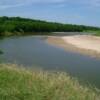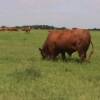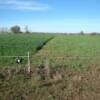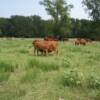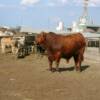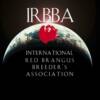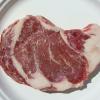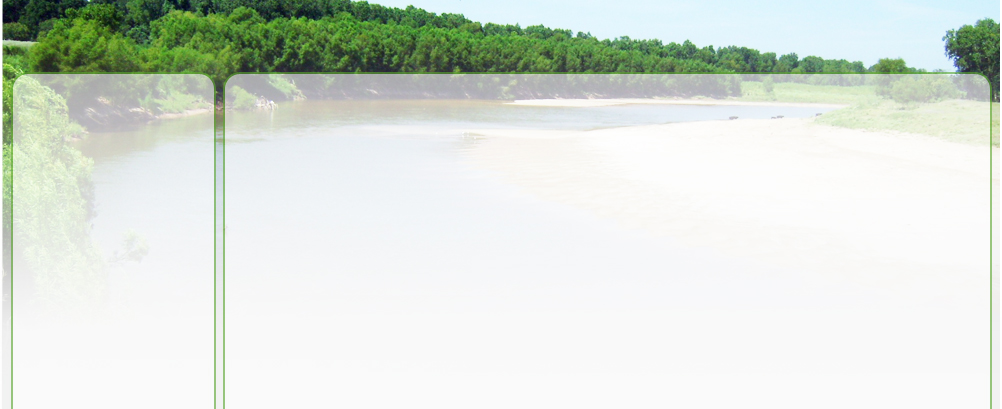


About Us
IN THE BEGINNING: This ranching and former cotton-farming community on the fertile soils along the banks of the Brazos River has been home to the Kmiec-Krotofil family since the late 1800's. Prior to 1985, various breeds of bulls were used on the commercial cattle herd. After studying the options, Steve Kmiec purchased Red Brangus bulls in 1985. We liked the calves and cows they produced, and so began acquiring registered Red Brangus genetics. The current 250+ commercial cowherd has evolved into primarily red Brangus genetics from over 25 years of breeding.
TRIANGLE K FARMS: Triangle K Farms is based in Chappell Hill, Texas, approximately 60 miles northwest of Houston, Texas. Dennis Kmiec started Triangle K Farms upon the purchase of property located near the Kmiec homestead in 1990. In 2013, Triangle K has approximately 120 breeding age Red Brangus females registered in the International Brangus Breeders Association (IBBA) database. These 3/8 Brahman X 5/8 Angus cattle are very well adapted for grazing and reproducing in this hot and humid Texas Gulf Coast climate.
CONTROL GRAZING: Our operation starts with grass productivity. Control grazing is an important management technique we utilize, also known as rational grazing or intensive grazing. Our first grazing cells were implemented about 1991 after educating ourselves with Allan Savory's Holistic Resource Management (book and course), Andre Voisin's Grass Productivity book, Burt Smith's Intensive Grazing Management book, Alan Nation's Stockman Grass-Farmer publication, and numerous other publications/authorities on the subject. We consider ourselves grass farmers first, and use the cow to harvest it. Less than 20% of the commercial operation land receives fertilizer, mainly the hay meadows. Excess grass is made into hay and fed to the herds in the winter.
GRASS EFFICIENT COWS and REPRODUCTION: Cattle are selected that reproduce best on grass (hay in the winter). The mature cowherd gets minimal protein supplement; in fact, the spring-calving commercial mature cowherd (approximately 200 head) gets no protein supplement, not even in the winter. Cattle are provided quality loose mineral and salt. The majority of the calves are born in the spring to coincide with nature's best grass nutrition. We have a spring and a fall calving season. Cows stay that reproduce under this grazing management system. Cows that don't reproduce are culled. A nice fat pretty commercial cow, under this system, usually means there is a problem. Our commercial cattle are efficient reproducers under typically limited conditions in this environment. The registered cowherd is provided supplementation in the winter. Their actual performance results in some of the overall best balanced EPDs for red cattle in the Brangus breed.
CARCASS TRAITS: We select seed-stock cattle for carcass traits as well as for their reproduction and grazing ability. Every year we utilize carcass trait ultrasound technology to evaluate and select our yearling registered heifers and bulls. Ultrasound technology is currently the best way to evaluate carcass traits on live animals. DNA markers are the future, but currently improvement is needed to solely, reliably correlate markers to actual traits. We have a unique sire breeding some of our seed-stock cattle. He is a bull we acquired that at 355 days old scanned 10.3% intramuscular fat (%IMF), 0.42" back fat thickness, 13.1 ribeye area, weighing 1146 lbs. The scanning technician is very reputable, and the scan image results were produced by the CUP lab in Iowa. This is an incredible %IMF score with desirably moderate weight, REA, and fat thickness numbers for a Brangus animal at that young age. In addition, his Igenity DNA tenderness score is a 9 (10 is their most tender score). For a comparison, one of the premier Angus breeders in the country has an impressive 5.2 %IMF average for his bulls. We hope this bull will contribute increased meat quality and tenderness for us, the breed, and meat consumers in the future. It is this type of beef quality that we are working to produce.
THE BEEF: The ultimate carcass test is eating your beef. Tough meat is tough meat, and tender tasty meat is tender tasty meat regardless of what the meat inspector, scan, or DNA markers indicate. An average year we taste meat cuts from about four different animals from our herd. Sometimes the experience is less than pleasant; fortunately most of the time it is very good. Information is learned either way, and used for future decisions.
MARKETING: Contact us to purchase cattle genetics for your program. Triangle K registered bulls and registered heifers are sold each year by private treaty or kept for replacements or herd sires. Our registered buyers are both domestic and international. Semen is available from our herd sires. Embryos are available from donor cows. The commercial heifers are either kept or sold to commercial breeders (via private treaty sales) as Brangus Gold replacement females. All commercial male calves and at least 50% of the male calves from the registered herd are cut, shipped to the feedlot after backgrounding, and marketed to the packer as Brangus OptimaxX calves.
PROMOTION: Triangle K is active in promoting Brangus cattle, Red Brangus in particular. We advertise in cattle publications, participate in cattle sales, exhibit cattle in local shows, participate in Brangus association committees and events, travel internationally to visit cattle breeders, and talk cattle to anyone interested on the subject, especially commercial cow-calf operators. We have been fortunate to have some cattle that did well in shows. Numerous champions have their lineage tied back to cows and bulls we were fortunate to have owned, bred and/or purchase. Although show cattle have nothing to do with our basic operation, they provide good advertising material and sales opportunities.
WE THE PEOPLE: For all the enjoyment the cattle have enriched our life, and it has been immense, the most rewarding part of the cattle business is the people. Cattle, especially registered cattle, provide an avenue to meet, socialize, and work with fellow cattle people all over the world. For the risk of leaving anyone out, we will refrain from naming the many special friendships that have evolved; they know who they are. We have been blessed to be a part of their lives, and have them a part of our lives. God bless all of them.
215 Bennington, Houston, TX 77022
Phone : 713.829.0270
Click on images to enlarge
